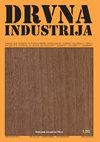Thermal Behavior of Insulation Fiberboards Made from MDF and Paper Wastes
IF 0.8
4区 农林科学
Q4 MATERIALS SCIENCE, PAPER & WOOD
引用次数: 0
Abstract
Today, recycling is becoming increasingly important. In recycling process, the product performance should also be considered. In this study, manufacturing insulation fiberboard, as a practical wood product from recycled fibers, was investigated. For this purpose, two types of waste (MDF wastes and waste paper) were recycled to fibers and used for producing insulation fiberboards. The target fiberboard density was 0.3 g/cm3. The ratio of waste paper to MDF waste recycled fibers (WP/RF) was considered at two levels of 70/30 and 50/50. Polyvinyl acetate adhesive was used as a variable in the board manufacturing process. The mechanical properties, dimensional stability, thermal conductivity, and fire resistance of the boards were evaluated. Besides, the thermal stability of fiberboards was studied using thermal analysis including thermogravimetric analysis (TGA) and differential thermal analysis (DTA). The results showed that the insulation fiberboards had admissible mechanical properties and dimensional stability. The manufactured boards displayed low thermal conductivity, which proved to be well competitive with other insulation materials. The fiberboards manufactured with PVAc adhesive and WP/RF ratio of 50/50 had higher fire resistance compared to other treatments. Additionally, results of thermal analysis showed that the use of PVAc adhesive and WP/RF ratio of 50/50 leads to improved thermal stability. Overall, the recycled fibers from MDF and paper wastes appear to be appropriate raw materials for manufacturing thermal insulation panels, and use of PVAc adhesive can significantly improve thermal and practical properties of insulation fiberboards.由中密度纤维板和废纸制成的绝缘纤维板的热性能
今天,回收变得越来越重要。在回收过程中,还应考虑产品的性能。本文研究了利用再生纤维生产实用木制品——保温纤维板。为此,将两种废弃物(中密度纤维板废弃物和废纸)回收为纤维,用于生产绝缘纤维板。目标纤维板密度为0.3 g/cm3。废纸与中密度纤维板(MDF)废再生纤维(WP/RF)的比例分别为70/30和50/50。聚氯乙烯胶粘剂作为一个变量在板材的制造过程中使用。评估了该板的机械性能、尺寸稳定性、导热性和耐火性。此外,采用热分析方法,包括热重分析(TGA)和差热分析(DTA),对纤维板的热稳定性进行了研究。结果表明,该保温纤维板具有可接受的力学性能和尺寸稳定性。制造的板显示出低导热性,这证明了与其他绝缘材料的竞争力。使用PVAc胶粘剂和WP/RF比为50/50的纤维板的耐火性高于其他处理。此外,热分析结果表明,使用PVAc胶粘剂和WP/RF比为50/50时,热稳定性得到改善。综上所述,从MDF和废纸中回收的纤维是制造保温纤维板的合适原料,使用PVAc胶粘剂可以显著提高保温纤维板的热性能和实用性能。
本文章由计算机程序翻译,如有差异,请以英文原文为准。
求助全文
约1分钟内获得全文
求助全文
来源期刊

Drvna Industrija
MATERIALS SCIENCE, PAPER & WOOD-
CiteScore
1.80
自引率
9.10%
发文量
32
审稿时长
>12 weeks
期刊介绍:
"Drvna industrija" ("Wood Industry") journal publishes original scientific and review papers, short notes, professional papers, conference papers, reports, professional information, bibliographical and survey articles and general notes relating to the forestry exploitation, biology, chemistry, physics and technology of wood, pulp and paper and wood components, including production, management and marketing aspects in the woodworking industry.
 求助内容:
求助内容: 应助结果提醒方式:
应助结果提醒方式:


